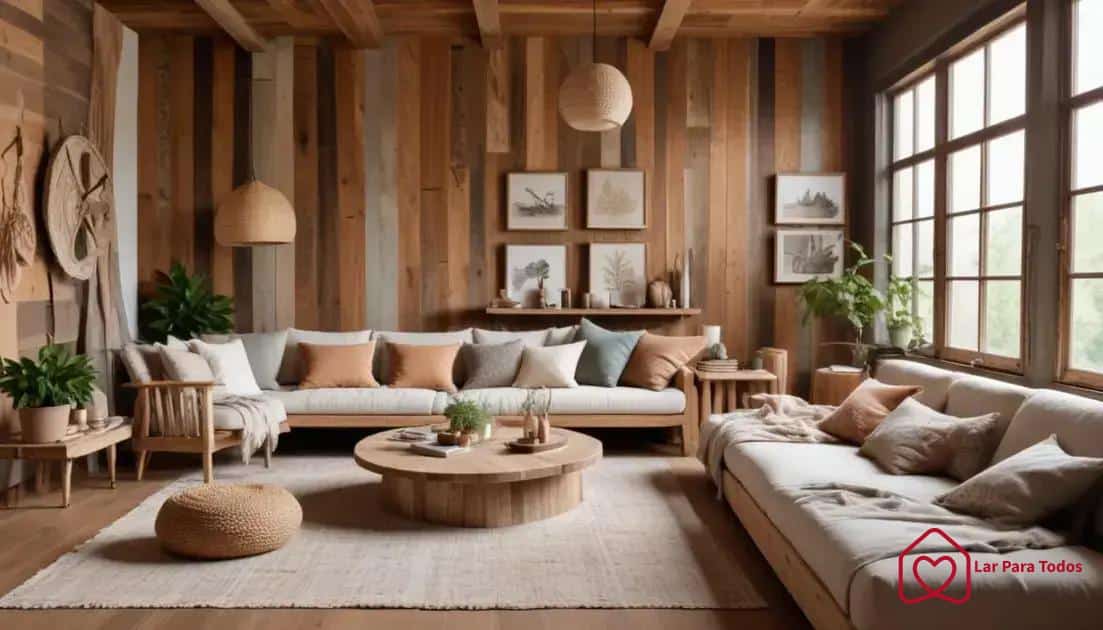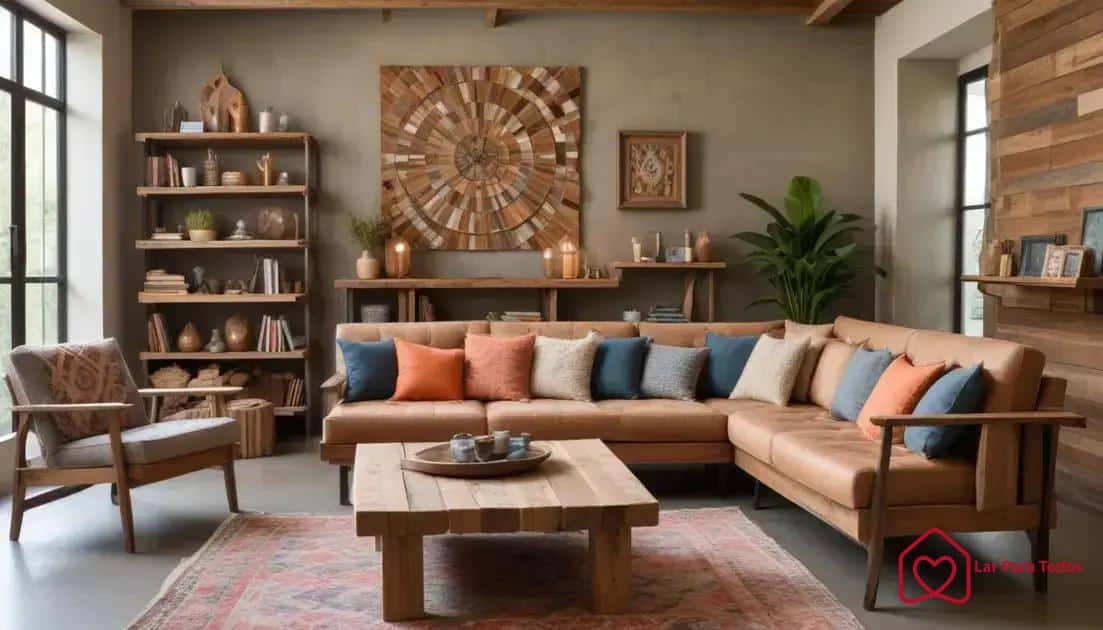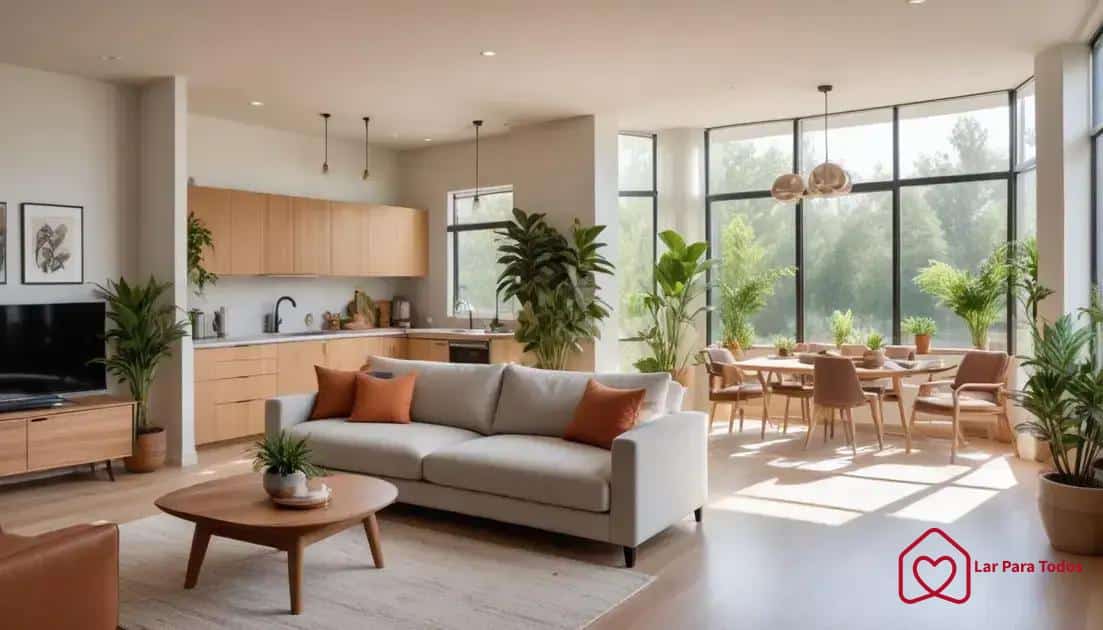Sustainable home decor trends: eco-friendly materials

Creating a sustainable home decor living space involves choosing eco-friendly materials, using energy-efficient appliances, and incorporating plants to enhance both aesthetics and environmental responsibility.
If you’re interested in transforming your living space, explore the world of sustainable home decor trends. These trends not only beautify your home but also contribute to a healthier planet.
Curious about how to style your space sustainably? Let’s dive into what makes eco-friendly materials a game changer in decorating.
Exploring sustainable materials for your home
Sustainable materials are not just a trend; they’re a way to make a positive impact on the environment. By incorporating eco-friendly options into your home, you can create a beautiful space while supporting a healthier planet.
These materials, such as renewable resources and recycled products, help reduce your carbon footprint while offering durability and style.
Choosing sustainable materials not only benefits the environment but can also improve energy efficiency and indoor air quality.
Whether you’re renovating or building from scratch, eco-friendly materials are a smart choice that can lead to long-term savings and a more responsible living space.
Types of Sustainable Materials
Understanding the different types of sustainable home decor materials is essential for making informed decisions. Here are some popular options:
- Reclaimed Wood: Using wood that has been salvaged from old buildings or furniture, reclaimed wood adds character and reduces waste.
- Bamboo: This fast-growing plant is strong and versatile, making it an excellent choice for flooring and furniture.
- Natural Fibers: Materials like cotton, linen, and jute are biodegradable and have a lower environmental impact.
- Recycled Materials: Incorporating products made from recycled materials decreases your carbon footprint significantly.
By choosing these materials, you are supporting sustainable practices and often gaining unique designs for your home. For instance, bamboo furniture is not only stylish but also durable, making it perfect for everyday use.
Benefits of Using Sustainable Materials
Switching to sustainable materials can have numerous benefits. They often possess qualities that enhance your living experience:
- Healthier Indoor Air Quality: Eco-friendly materials reduce harmful toxins that can accumulate in your home.
- Durability: Many sustainable products are designed to last longer, saving you money in the long run.
- Aesthetic Appeal: Sustainable décor often features natural textures and colors that can enhance any room.
Additionally, opting for these materials supports eco-friendly companies committed to sustainable practices. It’s a small choice that can lead to significant positive changes.
As you explore options for your home, consider how each choice can reflect not just your style but also your values. By carefully selecting sustainable home decor materials for your, you contribute to a more sustainable future while enjoying a beautiful living space.
Innovative eco-friendly design ideas
There are numerous innovative eco-friendly design ideas that can transform your home while minimizing your environmental impact.
By incorporating sustainable materials, energy-efficient solutions, and thoughtful design choices, you can create a space that is not only stylish but also eco-conscious.
These designs reflect your personal style and contribute to a healthier planet by reducing waste, conserving energy, and supporting environmentally responsible practices.
Whether through using reclaimed wood, installing energy-efficient appliances, or choosing natural lighting, every choice you make can have a positive effect on both your home and the environment.
Creative Ways to Use Recycled Materials
Using recycled materials in home decor is not just smart; it’s also creative. Consider repurposing old furniture or using materials like glass and metal to create stunning new pieces.
- Glass Bottles: Empty glass bottles can be turned into stylish vases or light fixtures.
- Pallet Furniture: Old pallets can be transformed into unique coffee tables or outdoor seating.
- Metal Can Planters: Cans can be painted and used as planters for indoor herbs or flowers.
These ideas allow you to express creativity while embracing sustainability.
Natural Color Palettes
A key element of eco-friendly design is using natural color palettes, which help create a calming atmosphere and connect your home to the outdoors.
Shades inspired by nature, such as soft greens, warm browns, and earthy tones, can make your space feel more inviting and grounded.
Incorporating natural materials like stone, wood, and clay can enhance this palette, adding unique textures and depth to the space. Each material brings its own character, contributing to the overall warmth and organic feel of the room.
These natural elements not only complement your color choices but also promote sustainability, ensuring your home remains both beautiful and eco-conscious.
Biophilic Design
Biophilic design focuses on integrating elements of nature into your home. This can be achieved through indoor plants, natural light, and organic shapes. Not only does it make your home feel alive, but it also promotes well-being.
- Indoor Gardens: Create an indoor garden with a mix of plants to improve air quality.
- Large Windows: If possible, install large windows that let in natural light.
- Natural Textures: Use materials that mimic forms and textures found in the outdoors.
These approaches bring the outside in, making your home a tranquil retreat while supporting your health.
As you explore these innovative eco-friendly design ideas, remember that small changes can lead to significant impacts. Each decision you make, from the materials you use to the colors you choose, can contribute to a more sustainable lifestyle.
Benefits of using recycled products

Using recycled products in your home offers far-reaching benefits that go beyond just aesthetic appeal. By choosing recycled items, you not only support sustainability but also gain practical advantages, such as durability, cost savings, and unique designs.
These products help reduce waste, conserve natural resources, and lower your carbon footprint, making them a responsible choice for any eco-conscious homeowner.
Additionally, many recycled products add character and originality to your space, creating a distinctive look that reflects your commitment to both style and the environment.
Environmental Impact
One of the most significant benefits of using recycled products is the positive impact on the environment. Recycling reduces waste and lowers the energy consumption required to create new products.
This means less pollution and a smaller carbon footprint, which is vital for protecting our planet.
- Less Landfill Waste: Recycling helps decrease the amount of waste in landfills, leading to cleaner environments.
- Conservation of Resources: Using recycled materials conserves raw materials, thus preserving natural habitats and ecosystems.
- Lower Energy Usage: Recycled products typically require less energy to produce than their new counterparts.
By choosing recycled items, you play a key role in conserving our planet’s resources.
Economic Advantages
In addition to environmental benefits, using recycled products can also have economic advantages. These items can often be more affordable because recycling processes can reduce production costs.
Plus, as demand for recycled goods increases, it supports job creation in recycling and manufacturing industries.
By supporting businesses that use recycled materials, you help stimulate sustainable economic growth. This leads to more jobs and a stronger economy.
Unique Aesthetic Appeal
Recycled products can add a unique touch to your home decor. Many recycled items feature one-of-a-kind designs that are not only stylish but also tell a story.
From furniture made of reclaimed wood to art created from salvaged materials, these pieces often carry character and history.
Integrating such products into your decor can create distinctive looks that reflect your personality while promoting sustainability.
By embracing recycled products, you enjoy numerous benefits, from reducing environmental impact to enhancing your home’s aesthetic. Each choice to go green adds to a larger movement towards sustainability, making a difference one decision at a time.
How to choose sustainable brands
Choosing sustainable brands is a crucial step toward living a more eco-friendly lifestyle. With so many options available, it can be overwhelming, but understanding key criteria can simplify your decision.
Look for brands that prioritize environmentally responsible practices, such as using renewable materials, reducing waste, and minimizing their carbon footprint.
Additionally, consider brands that promote ethical production processes and fair labor practices. By focusing on these factors, you can make informed choices that align with your values while supporting businesses committed to sustainability.
Research Brand Practices
Start by researching a brand’s practices. Look for information on how they source materials, their manufacturing processes, and their commitment to environmental sustainability.
Brands that prioritize ethically sourced materials and fair labor practices often demonstrate a strong commitment to sustainability.
- Materials Used: Check if the brand uses organic or recycled materials.
- Manufacturing Process: Learn about their production methods and energy usage.
- Fair Trade Certification: Brands with fair trade practices ensure better wages for their workers.
By focusing on these factors, you can identify brands that align with your values.
Look for Certification Labels
Certification labels can guide you to more sustainable choices. Look for well-known certifications that indicate a brand’s commitment to environmental and social responsibility. These certifications provide assurance that the brand meets certain standards.
- Global Organic Textile Standard (GOTS): Indicates organic fibers and eco-friendly manufacturing.
- Fair Trade Certified: Ensures ethical labor practices.
- Energy Star: Designates energy-efficient products.
These labels can simplify your search for sustainable brands, making it easier to choose products that are better for the planet.
Evaluate Brand Transparency
Transparency is a key indicator of a brand’s commitment to sustainability. Brands that openly share their sustainability goals, practices, and challenges are usually more trustworthy. Check their websites or social media for information about their environmental initiatives.
Brands willing to discuss their impact on the environment and community demonstrate accountability. This transparency can guide you in making informed choices.
As you navigate the world of sustainable brands, remember that every purchase contributes to a larger movement. By choosing wisely, you not only support ethical practices but also help inspire others to make similar choices.
Affordable eco-friendly decor options
Finding affordable eco-friendly decor options can make sustainable living accessible to everyone. You don’t have to break the bank to create a stylish and environmentally friendly home.
DIY Decor Projects
One of the best ways to save money and decorate sustainably is by creating your own decor. There are countless DIY projects that can utilize recycled or natural materials. Not only are they cost-effective, but they also add a personal touch to your space.
- Recycled Bottles: Turn old glass bottles into beautiful vases or candle holders.
- Pallet Furniture: Use reclaimed pallets to craft unique furniture pieces like coffee tables or shelves.
- Fabric Scraps: Sew fabric scraps to make decorative pillows or wall hangings.
These projects allow for creativity while being budget-friendly.
Shop Second-Hand
Shopping second-hand is an excellent way to find unique eco-friendly decor. Thrift stores, garage sales, and online marketplaces often have a variety of items at lower prices.
You can discover vintage furniture, art, and decor that add character to your home without the environmental impact of new production.
By choosing second-hand items, you contribute to less waste and can still create a beautiful space. Look for pieces that align with your style and can be easily updated with a fresh coat of paint or new hardware.
Use Natural Elements
Incorporating natural elements into your decor can be both affordable and elegant. Simple items like plants, stones, or wood can dramatically enhance your space and bring a sense of calm. Consider using:
- Houseplants: Indoor plants purify the air and add liveliness.
- Natural Fabrics: Use items made from hemp, cotton, or linen for curtains and cushions.
- Driftwood: Collect driftwood for art projects or as decorative elements.
These items not only elevate your decor but also support a sustainable lifestyle.
Affordable eco-friendly decor options are within reach for everyone. With a little creativity and resourcefulness, you can beautify your home while being kind to the planet.
Creating a sustainable living space

Creating a sustainable living space is essential for anyone looking to reduce their ecological footprint. With the right approach, you can design a home that is both beautiful and environmentally friendly.
Choose Sustainable Materials
Start by selecting sustainable materials when furnishing and decorating your space. Opt for items made from recycled, reclaimed, or natural materials. This choice helps reduce waste and minimizes the need for new resources.
- Bamboo: Fast-growing and renewable, bamboo is perfect for flooring and furniture.
- Recycled Glass: Use recycled glass products in your decor for vases or light fixtures.
- Organic Cotton: Choose organic cotton for curtains and upholstery to avoid harmful chemicals.
Using these materials not only helps the environment but can also add unique character to your home.
Incorporate Energy Efficiency
Another crucial aspect of a sustainable living space is energy efficiency. By considering how energy is used in your home, you can make environmentally responsible choices that lead to long-term savings.
Simple changes, such as installing energy-efficient appliances and LED lighting, can significantly reduce your energy consumption while also lowering utility bills.
In addition, adding insulation to your home helps maintain a comfortable temperature year-round, reducing the need for excessive heating or cooling.
These small adjustments not only make your home more eco-friendly but also contribute to a more cost-effective and comfortable living environment.
Bring in Nature
Integrating plants into your living space enhances air quality and connects you to nature. Choose indoor plants that thrive well in your environment. Not only do they beautify your home, but they also absorb carbon dioxide and release oxygen.
Some great options include snake plants, peace lilies, and pothos. Even small potted herbs can make a lovely addition to your kitchen while providing fresh flavors for your meals.
Creating a sustainable living space involves thoughtful choices about materials, energy, and nature. By making these changes, you can build a home that’s not only stylish but also kind to the planet.
FAQ – Frequently Asked Questions About Creating a Sustainable Living Space
What are some affordable ways to decorate sustainably?
You can start with DIY projects using recycled materials, shop at thrift stores, and incorporate natural elements like plants.
How can energy efficiency be improved in my home?
You can improve energy efficiency by using LED lights, energy-efficient appliances, and adding insulation to reduce heating and cooling needs.
Why should I choose eco-friendly materials?
Eco-friendly materials reduce waste and resource consumption, helping to protect the environment and improve indoor air quality.
What types of indoor plants are best for improving air quality?
Plants like snake plants, peace lilies, and pothos are excellent choices, as they can purify the air while adding beauty to your space.





